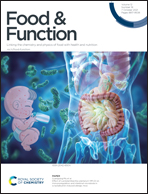A comparative study of the effects of different fucoidans on cefoperazone-induced gut microbiota disturbance and intestinal inflammation†
Abstract
Antibiotic abuse can lead to gut microbiota disturbance and intestinal inflammation, which in turn may lead to serious inflammatory bowel disease and metabolic syndromes. To investigate the effect of fucoidan on alleviation of the side effects of antibiotics and its structure–activity relationship, we compared the effects of two fucoidan fractions with medium and low molecular weights (MF and LF) from Laminaria japonica on microbiota dysbiosis, colonic inflammation and intestinal mucosal damage in a cefoperazone-induced intestinal injury mouse model. Our results showed that oral administration of 200 mg kg−1 LF (Mw = 1.13 kDa) and MF (Mw = 26.7 kDa) together with 100 mg kg−1 cefoperazone for 10 days could significantly alleviate weight loss, colon shortening and enlargement, mucosal structural damage in the small intestine, cecum and colon induced by cefoperazone in mice. Meanwhile, LF and MF also significantly suppressed the overproduction of TNF-α, IFN-γ, and IL-6 in the colon; however, LF can restore the decrease in the levels of TNF-α and IL-6 in the small intestine and the decrease in the levels of TNF-α, IFN-γ, and IL-6 in the cecum induced by cefoperazone in mice. We found that the molecular weight of fucoidan plays an important role in the regulation of the gut microbiota in antibiotic-treated mice. Interestingly, fucoidans with different molecular weights resulted in quite different caecal microbiota communities. MF exhibited a much better effect on the restoration of the gut microbiota community richness and diversity and the beneficial bacterium Muribaculaceae. However, LF resulted in the dominance of bacteria including Staphylococcus in cefoperazone treated mice, without an increase in the community richness and diversity of caecal microbiota. In the LF and MF treated mice, an increase in the abundance of beneficial bacteria, Muribaculaceae, Acinetobacter_lwoffii and Alloprevotella, and a decrease in the abundance of harmful bacteria, e.g., Parasutterella, Helicobacter and Enterococcus were also observed. Considering the negative effect of LF on the gut microbiota, MF with a molecular weight of 26.7 kDa seemed to be a more suitable choice of prebiotics for patients receiving cefoperazone treatment.



 Please wait while we load your content...
Please wait while we load your content...